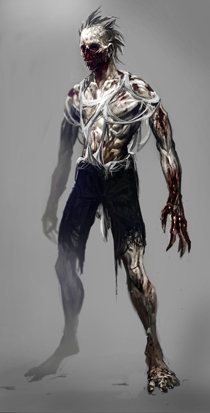State of Decay: Putting the ‘kill’ in ‘skill’
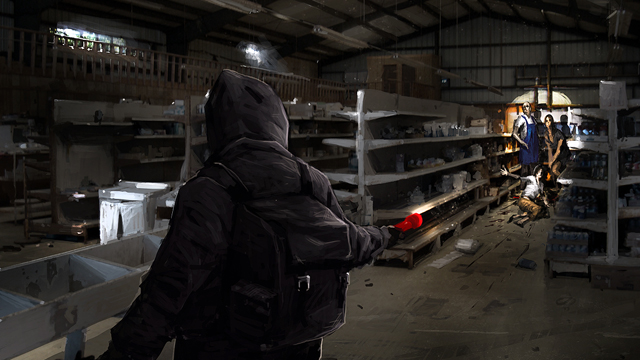 Surviving the end of the world takes skills. Skills developed in the slavering clutches of the undead, shaping wads of helpless victims into chiseled survivors. Everyone has their own strengths: the brawler, the sneak, the deadeye. Understanding your role in the zombie apocalypse could mean the difference between a lukewarm canned meal at the end of a long day and becoming the meal yourself. Undead Labs’ Richard Foge recently delved into the meaning of tactics, strategy, and how to last long enough to become a survivor in State of Decay.
Surviving the end of the world takes skills. Skills developed in the slavering clutches of the undead, shaping wads of helpless victims into chiseled survivors. Everyone has their own strengths: the brawler, the sneak, the deadeye. Understanding your role in the zombie apocalypse could mean the difference between a lukewarm canned meal at the end of a long day and becoming the meal yourself. Undead Labs’ Richard Foge recently delved into the meaning of tactics, strategy, and how to last long enough to become a survivor in State of Decay.
“In State of Decay we put a lot of effort into making sure that players can transition smoothly between different tactical approaches to gameplay so that [you] can adapt quickly and make adjustments to your tactics as the combat situation evolves,” he writes. Foge brings considerable console game design know-how to State of Decay, having honed his craft as a Senior Designer for the SOCOM franchise, in addition to combat and systems design for God of War and Guild Wars, respectively. Now he’s set sights on ensuring your survival’s as organic as possible.
“We want you to easily flow from stealth to melee combat to ranged combat to using items. We know that everyone approaches these challenges differently, and it was important to make sure that as many approaches were accounted for as possible.” There’s a dizzying array of ways to tackle the flesh-eating obstacles infesting State of Decay — for one, literally. Though Foge discourages too much physical contact when interacting with your new neighbors, “It’s a great way to get yourself killed, but it’s also a great way to dispatch a couple of zombies without letting the legions of the damned know your exact position.”
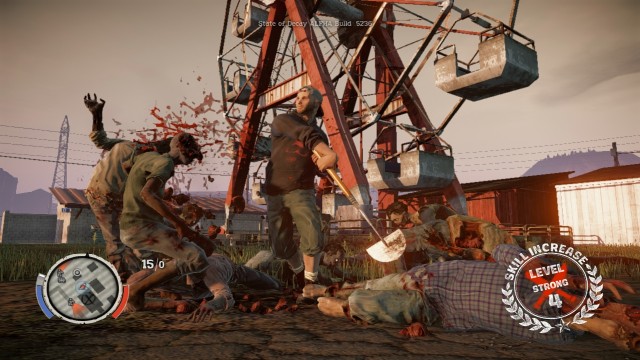 State of Decay‘s melee weapons are classified by their function and intended purpose. Light blunt weapons (baseball bats, metal pipes) are handy when looking to pulp a brain or knock back a shambling corpse. As Foge puts it, “Solid crowd control, not bad for killing.” Light edged weapons cleave heads with ease, if you’re accurate. “Just don’t depend on them being able to get you any space if you miss the headshot, ’cause zombies don’t appear to really care if you just cut them. Very fast, just not great at dealing with groups,” he warns.
State of Decay‘s melee weapons are classified by their function and intended purpose. Light blunt weapons (baseball bats, metal pipes) are handy when looking to pulp a brain or knock back a shambling corpse. As Foge puts it, “Solid crowd control, not bad for killing.” Light edged weapons cleave heads with ease, if you’re accurate. “Just don’t depend on them being able to get you any space if you miss the headshot, ’cause zombies don’t appear to really care if you just cut them. Very fast, just not great at dealing with groups,” he warns.
Heavy weapons are designed to make an impact — slow to swing but devastating to whole packs if you land your blow. This arms-reach arsenal serves in a pinch, but you want to drop zombies from a distance as often as you can afford. That means guns, lots of guns. We previously showcased the staggering variety of firearms found within State of Decay, but like melee weapons, guns are tools for survival, and — as Foge describes the many classes of hardware, it’s clear — there’s a tool for every job.
“I love finding them in the game and I think you will too,” proclaims Foge. “Your choice of firearm can also influence how you approach situations from a tactical perspective.” Pistols are persuasive close range, especially suppressed, though they’ve been known to jam. Revolvers are equally effective, and more reliable, but require constant reloading. For long range engagements, he recommends a rifle, “You can get more than one guy in a single shot with some of the beefier ones! That’s pretty handy.”
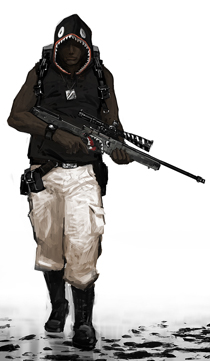 Submachine guns and assault rifles decimate the undead, burning through crowds as easily as bullets, and as Foge says, “it’s not like we have an infinite supply of those.” But the workhorse of the post-zombie-apocalypse, has to be the shotgun. “Up close they basically turn zombies into puddles of black goo. Ammo is pretty reasonable to get, too. They are kinda perfect,” he writes. Though he’s quick to qualify, “Except that they are crazy loud … so once that horde is gone, you’re pretty much guaranteed another one if you stay in the area.”
Submachine guns and assault rifles decimate the undead, burning through crowds as easily as bullets, and as Foge says, “it’s not like we have an infinite supply of those.” But the workhorse of the post-zombie-apocalypse, has to be the shotgun. “Up close they basically turn zombies into puddles of black goo. Ammo is pretty reasonable to get, too. They are kinda perfect,” he writes. Though he’s quick to qualify, “Except that they are crazy loud … so once that horde is gone, you’re pretty much guaranteed another one if you stay in the area.”
Noise is certainly a factor when packs of cannibalistic corpses roam the streets, and there are perks to avoiding clomping through infested territory. “When you’re moving around stealthily you don’t become completely invisible to the zeds, but you make barely any noise at all and their vision isn’t all that hot. It’s also a great way to sneak up behind a lone zed and take him out without alerting every other zombie in the area,” suggests Foge.
However, noise isn’t always a hindrance. As we saw in Undead Labs’ video teaser last month, sound can be a great tool to draw attention away from your objective, or tender meaty bits. Foge dishes on the explosive nature of items in State of Decay, “Options include improvised bombs, incendiaries, mines, homemade explosives, and more. They can be used to distract, burn, or blow up the enemy. Sometimes all at once.” He continues, “They are a great way of making an impossible situation a little bit less so. It’s up to you to find them, build them, and use them in the best way you can.”
For all that lethality, sometimes the best tactic in a scary situation is just to tuck tail and run — live to fight another day, as the saying goes. “Seriously, one of the most useful skill you can develop is recognizing when you are in over your head and getting the hell out of dodge,” states Foge. He’s pretty clear, when it comes to State of Decay, nothing’s sacred, “Those precious melee weapons tend to break at the most inconvenient moments, and your fancy submachine gun is a complex beast made up of lots of moving parts that is going to jam on you one day. Best to keep that in mind.”
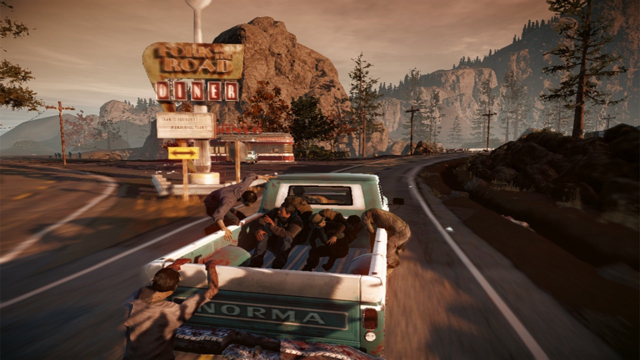 When you want to make a quick getaway, sometimes running just doesn’t cut it. For times like these, the vehicles of State of Decay might be more your speed, according to Foge. “Cars are awesome. Just be careful … Sure, it sounds like fun on paper. Zombie apocalypse, get in a fast car and do whatever you want. But getting into an accident can leave your survivors hurt real bad.” He emphasizes the importance of risk mitigation, “Vehicles are finite, and survivors aren’t invincible. One wrong move and one of your most useful tools is gone.”
When you want to make a quick getaway, sometimes running just doesn’t cut it. For times like these, the vehicles of State of Decay might be more your speed, according to Foge. “Cars are awesome. Just be careful … Sure, it sounds like fun on paper. Zombie apocalypse, get in a fast car and do whatever you want. But getting into an accident can leave your survivors hurt real bad.” He emphasizes the importance of risk mitigation, “Vehicles are finite, and survivors aren’t invincible. One wrong move and one of your most useful tools is gone.”
Whatever tactics you plan to adopt in coping with the outbreak, it’s important to make sure you’re getting the most bang for buck when choosing a survivor for a task. Foge elaborates, “The skills of your current survivor will absolutely influence your tactics in the field. Of course some survivors have natural talents that are going to allow them to grow a lot more in a particular area.” Working on those skills develops your survivor over time, allowing them to choose specializations that suit their abilities.
“Specializations are skills that reinforce your survivors natural expertise and play style. The choices you make about how your survivors grow is critical. It expands their tactical capabilities,” stresses Foge. “Is it more useful to have a survivor that can pick locks, or one that can move quickly in stealth? Do you want the crack shot … the unstoppable bruiser? There are a lot of different types of objectives … and each of your survivors can help you get there in different ways.”
Diversification seems to be the key to success for a well-balanced community, but beware; no one excels at everything. “The choices you make are also final. Once you’ve chosen a specialization for a survivor it is permanently part of that survivor,” Foge warns.
He also cautions against becoming too reliant on any one person. “It’s important to note that no matter how awesome one of your survivors ends up being (as you customize them via the Skills system), eventually they’re going to get tired out in the field. So tired that it may literally cost them their lives. Don’t put all your eggs in one basket. Have a deep bench.”
The many tactics Undead Labs are striving to incorporate are merely pieces in a much larger puzzle. Ultimately, it’s up to each of us to decide how those pieces fit together, surviving the undead scourge day by day. Whether that be with fire and sword, stealth and surprise, hit-and-run mobility or some combination thereof — every tough decision is yours to make, in a State of Decay.


